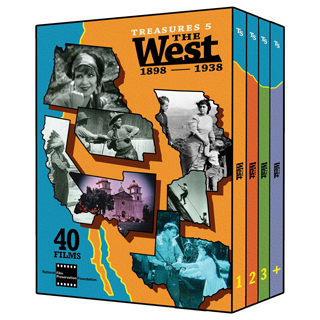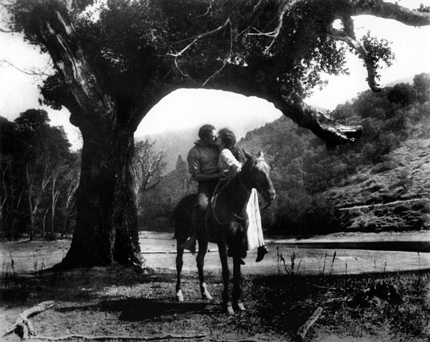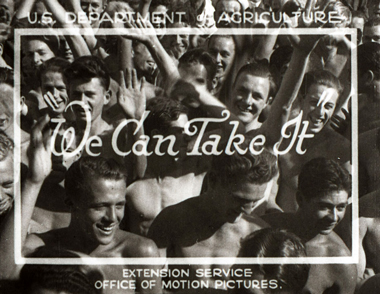|
|
Treasures 5:
The West 1898 - 1938
The National Film Preservation Foundation

|
Treasures 5: The West
1898 - 1938
The National Film Preservation Foundation / Image
1898-1938
B&W & Color / 1:33 flat / 596 minutes / Street Date September 27, 2011 / 59.98
Commentary: Richard Abel, Blaine M. Bartell, Robert S. Birchard, Carolyn Brucken, Annie Gilbert Coleman, Todd DePastiino, William Deverell, Stephen Gong, Tom Gunning, Randy Haberkamp, Lynne Kirste, Neal M. Maher, Desirée A. Martin, Brian Meacham, Russell Merritt, Michael Miller, Bill Moore, Jennifer Peterson, Donald W. Reeves, Gary Scharnhorst, Michael Sragow, Louis S. Warren.
Disc design Jennifer Grey-Berkowitz
Original Music: Todd DePastino, Mark Harvey, Stephen Horne, Martin Marks, Andrew McPherson, Michael Miller, Michael D. Mortilla, Brian Robison, Elena Ruehr, Charles Shadle, Christine Southworth, Evan Ziporyn.
Curators Scott Simmon, Martin Marks
|
|
|
|
|
Reviewed by Glenn Erickson
The National Film Preservation Foundation has released five DVD disc sets in eleven years under the name Treasures from American Film Archives. Each compilation of rare and restored film is indeed a treasure of cinematic delights. The films featured reach back to the first years of the 20th century and cover an eclectic range of topics, from entire features to vintage newsreels of historic events.
The third Treasures box concentrated on films about Social Issues, and volume four collected a group of Avant-garde films from the post- WW2 years. The new set Treasures 5: The West 1898 - 1938 examines the symbiotic relationship between film and the American West, from multiple angles. Not only are we given a wide range of early cowboy two-reelers and features, but also government and sponsored films about the development of Western resources, movies that encouraged rail and automobile tourism, and an occasional controversial newsreel.
The films have been sourced from film archives across the country; the Treasures series is a collaborative inter-archival effort. A couple of rarities were found only recently in New Zealand, and 'repatriated' to their country of origin.
As before, the discs employ an easy-to-access menu system. Extensive, authoritative liner essays are readable on the screen or from a hefty, durable program book. Each selection is encoded with alternate tracks, one with an expert historical commentary and another with a new musical soundtrack. The first surprise with this Archives collections is discovering how entertaining these vintage movies can be. Seen in good restorations at their proper projection speed, the films' dramatic and comedic values no longer seem quite so dated.
Program One
The volume opens with The Tourists (1912, 6 minutes), a Mack Sennett comedy. Comedienne Mabel Normand stops off for a bit of fun at a train-stop "Indian Demonstration" operated by The Harvey Company. The commentary and essay describe the relationship between Harvey and the railroads, and describe how these Indian crafts and customs shows actually kept Native American traditions alive.
The Sergeant (1910, 16 minutes) is a film rediscovered in the New Zealand Film Archive. Moving West for his health, actor Hobart Bosworth stars in an abbreviated love story / chase film. The show was filmed in Yosemite before it became a National Park, when the U.S. Cavalry was in charge.

Salomy Jane (1914, 87 minutes) is a feature western from a story by Bret Harte, 'produced in the California Redwoods.' It's an accomplished and sophisticated show, with camera angles and pacing that seem advanced for its year of release. Its 'western' star is Beatriz Michelena, the daughter of an immigrant from Venezuela.
Sunshine Gatherers (1921, 10 minutes) is a production of the Del Monte Company in the alternating-frame Prizma color process -- whenever an object moves, its outlines are bordered with solid color. Handsomely costumed recreations show the arrival of Father Serra and the various Spanish Missions built up the coast; the history given is the whitewashed version from the European side. And lots of fresh fruit is harvested as well!
The eccentric travelogue Deschutes Driftwood (1916, 10 minutes) shows the Deschutes River in Oregon from the point of view of a special traveler, a Hobo named Weak Knees Walter. The man is seen happily riding the rails until the brakeman "escorts" him off the train -- repeatedly. Besides being (inadvertently?) sympathetic to Walter, the movie shows sections of the Oregon landscape later inundated by a system of dams.
The "Promised Land" Barred to Hoboes (1936, 2 minutes) reveals a more typical attitude toward the itinerant homeless. Hobos were usually young men hopping the rails to travel to jobs, but this newsreel applies the term to people fleeing farm repossessions in the Midwest Depression. The Los Angeles Police chief unilaterally turned these people away at the border until stopped by public outcry. The under-capitalized citizens shown under arrest look just like the Oakies of The Grapes of Wrath. We learn that Woody Guthrie's song "This Land is Your Land" was written in protest to this practice.
Last of the Line (1914, 26 minutes) is a fascinating western, filmed with Native American performers brought to California for the winter months. As in the 1950s film Arrowhead, the chief's son (Japanese-American actor Sessue Hayakawa) returns from an Eastern college a changed man. The boy gathers a group of renegades to rob the Army, threatening the peace pact. The wise chief resolves the matter in the only way possible.

The Indian-detour (1926, 16 minutes) shows how the railroad tourism industry previewed the West for Eastern tourists. Animated maps follow a side trip through "Indian Country" in New Mexico, as vacationers in cars and buses stop off at scenic spots and more "Indian Demonstration" opportunities to buy hand crafted goods. According to the commentary, the railroad matched the sales price of Native American goods, to encourage the locals to put on these shows.
Native Americans in Newsreels (1921-38, 5 minutes) are brief newsreel bits using Indians as a novelty. They meet with congressmen in Washington D.C., take part in a ceremony commemorating The Little Big Horn and take their last fish from a northwestern river before a dam shuts the fish out forever.
We Can Take It (1935, 21 minutes) is a lengthy silent promotional piece for the Civilian Conservation Corps, the successful New Deal program that put thousands of young men to work improving public nature preserves -- building trails, cutting firebreaks, etc. It's quite an inspiring show; we see the entire process of induction and camp life in detail. The program ended with the beginning of WW2 and the enlistment of 90% of the CCC men into the armed services.

Program Two
Over Silent Paths (1910, 16 minutes) is a trim D.W. Griffith short starring Marion Leonard, that like Last of the Line emphasizes the movies' more open attitude toward women and minorities before the studios took over Hollywood. Her father murdered, a pioneer girl takes personal responsibility for uncovering the killer. One scene was filmed at the Mission San Fernando, then an abandoned ruin being used as a pig farm!
The realistic Life on the Circle Ranch in California (1912, 12 minutes) looks at cowboy life without the romantic trimmings. Commentator Donald W. Reeves critiques the film's accuracy and gives it generally high marks. Reeves doesn't think real cowboys would just dump their saddles in a pile in the dirt -- I'd guess that the actors were showing their contempt for being told to do everything twice as fast as normal.
Broncho Billy and the Schoolmistress (1912, 14 minutes) is a comedy-drama about yet another girl from the East who doesn't need to be protected from the local dangers. Broncho Billy plays a passive role, and even takes a bullet when a jealous villain tries to eliminate him from the new teacher's dance card.
How the Cowboy Makes His Lariat (1917, 3 minutes). Cowboying is a lot tougher than it looks, as we see horsehair harvested and then woven into the scratchiest-looking ropes one could imagine. These cowpokes weave their own saddle cinches too.
Mexican Filibusters: An Incident in the Recent Uprising (1911, 16 minutes) is a genuine oddity, an American film that takes the side of a pair of revolutionary lovers (Pedro & Blanca) as they smuggle arms to the Villistas across the border. The federal agents even congratulate the pair after a successful handoff. The scene reminds us of a chapter in Sam Peckinpah's The Wild Bunch.
The one-reeler The Better Man (1912, 12 minutes) is another exceptional show, with a surprising attitude toward Mexican Americans. Disgusted with her wastrel of a husband, a distraught mother decides that a wanted Mexican outlaw who risks capture to bring a doctor for her sick child is a better man. Commentator Richard Abel decodes the pantomime style of acting -- we know the outlaw can do no wrong when he crosses himself before a picture of the Virgin Mary.
Ammunition Smuggling on the Mexican Border (1914, 41 minutes) tells the true tale of a Texas lawman taken prisoner by Villa revolutionaries, an incident that led to a murder trial for twelve resident Mexicans. The commentary reminds us that the legends of the West were written by the winners, and the one who tells the story usually gets to wear the white hat.
Lake Tahoe, Land of the Sky (1916, 6 minutes) begins with a train arriving during a blizzard at Truckee, California and then proceeds to show how new roads have made Lake Tahoe a perfect vacation destination. The lake must have been a remote paradise in 1916; it was still pretty wonderful and pristine in 1964...

Some of the previous Treasures sets (still available) contain well-known Hollywood features unreleased on DVD. This volume gives us Mantrap (1926, 71 minutes), a clever, funny comedy directed by Victor Fleming and starring Clara Bow at her most frisky. A lawyer escapes to the woods for a vacation away from bothersome females, only to be enchanted by Bow's irrepressibly physical attractiveness. With Percy Marmont, Ernest Torrence and an impossibly non-fat Eugene Pallette. This is said to be Ms. Bow's favorite film.
The Golden West (excerpt) (1938, 8 minutes) is a brief Los Angeles travelogue seen from the air as well as on the ground. The film was shot in 1st generation Kodachrome with its more subdued colors; this excerpt isn't much more than a teaser of a 90-minute original. One Californian gift to culture presented is our open-air drive-in cafés.
Program 3
The feature film The Lady of the Dugout (1918, 64 minutes) was produced by Al Jennings, a reformed ex-outlaw. Twenty years after his violent career, he starred himself in a movie about his crooked exploits, recreating his most notorious crimes. Naturally, Jennings casts himself as a hero.
Passing of the Oklahoma Outlaw (excerpt) (1915, 13 minutes) sees another side of the story of the outlaw Al Jennings, who had made other self-promoting films. In response, lawman William Tilghman produced this film to set the record straight. Only a little more than one reel survives of what was a longer film.
The Girl Ranchers (1913, 14 minutes) is an amusing but also thoughtful western comedy about gender roles out West. Women take possession of a ranch but alienate the hired cowboys by asking that they shave their mustaches. The women then teach themselves to work the spread on their own.
Legal Advice (1916, 13 minutes) Tom Mix, the first cowboy star, stresses action and stunts in this comedy tale of a lady attorney arriving from the East. Silent film authority Robert S. Birchard's commentary provides a wealth of information about practically every actor we see on screen.
Womanhandled (excerpt) (1925, 55 minutes) is a feature from director Gregory LaCava starring Richard Dix and Esther Ralston. A Manhattan playboy invites a girl to see his Texas property, and then must buy the cooperation of his ranch hands to create the "Wild West" illusion she expects to see. LaCava's expert handling of comedy is already in evidence. The ranch hands are forced to appropriate items from museums to dress up the ranch.

Beauty Spots in America: Castle Hot Springs, Arizona (1916, 6 minutes) is a promotional travelogue intended to lure Easterners to a winter hideaway: "No wind, no fog!" The picture postcard views stress the beautiful landscape (with imported palm trees) and the modern amenities.
Romance of Water (1931, 10 minutes) and A New Miracle in the Desert (1935, 1 minute) are part of the public relations snow job that accompanied the Los Angeles Department of Water and Power's grab of water from the Owens Valley and the Colorado River via lengthy pipelines. The name Mulholland is heard, making these a perfect opening teaser for the movie Chinatown. Not only did California dump "hoboes" in their neighbor state, it also more or less stole Arizona's share of Colorado River water.
The West in Promotional Travelogues (1898-1920, 22 minutes) gathers eight brief films featuring the wonders of the West as an inducement to tourism. Railroads are a main sponsor of these, it seems -- we see glimpses of Colorado's Glenwood Springs, a mine in Utah, Yosemite, and Yellowstone.
Image Entertainment's DVD box of The National Film Preservation Foundation's Treasures 5: The West 1898 - 1938 is an impressive entertainment but also a college-worthy educational tool. The comments and essays accompanying the films are authoritative and fully annotated. The set's booklet includes an interesting opening essay about the relationship of film to the "aura" of the West. The entries also give the transfer frame rates for individual silent films -- from 16 to 22 frames per second. Seeing these shows at their proper frame rate makes a big difference.
Note: Can't quite picture what this collection might look like? A Treasures 5 Trailer is now viewable at the NFPF Website.
On a scale of Excellent, Good, Fair, and Poor,
Treasures 5: The West 1898 - 1938 rates:
Movies: Excellent
Video: Excellent
Sound: Excellent
Supplements: Book of essays and notes.
Packaging: Three slim cases in sturdy card box
Reviewed: August 30, 2011
Republished by permission of Turner Classic Movies.
DVD Savant Text © Copyright 2011 Glenn Erickson
See more exclusive reviews on the Savant Main Page.
Reviews on the Savant main site have additional credits information and are often updated and annotated with reader input and graphics.
Also, don't forget the
2011 Savant Wish List.
T'was Ever Thus.
Return to Top of Page
|

